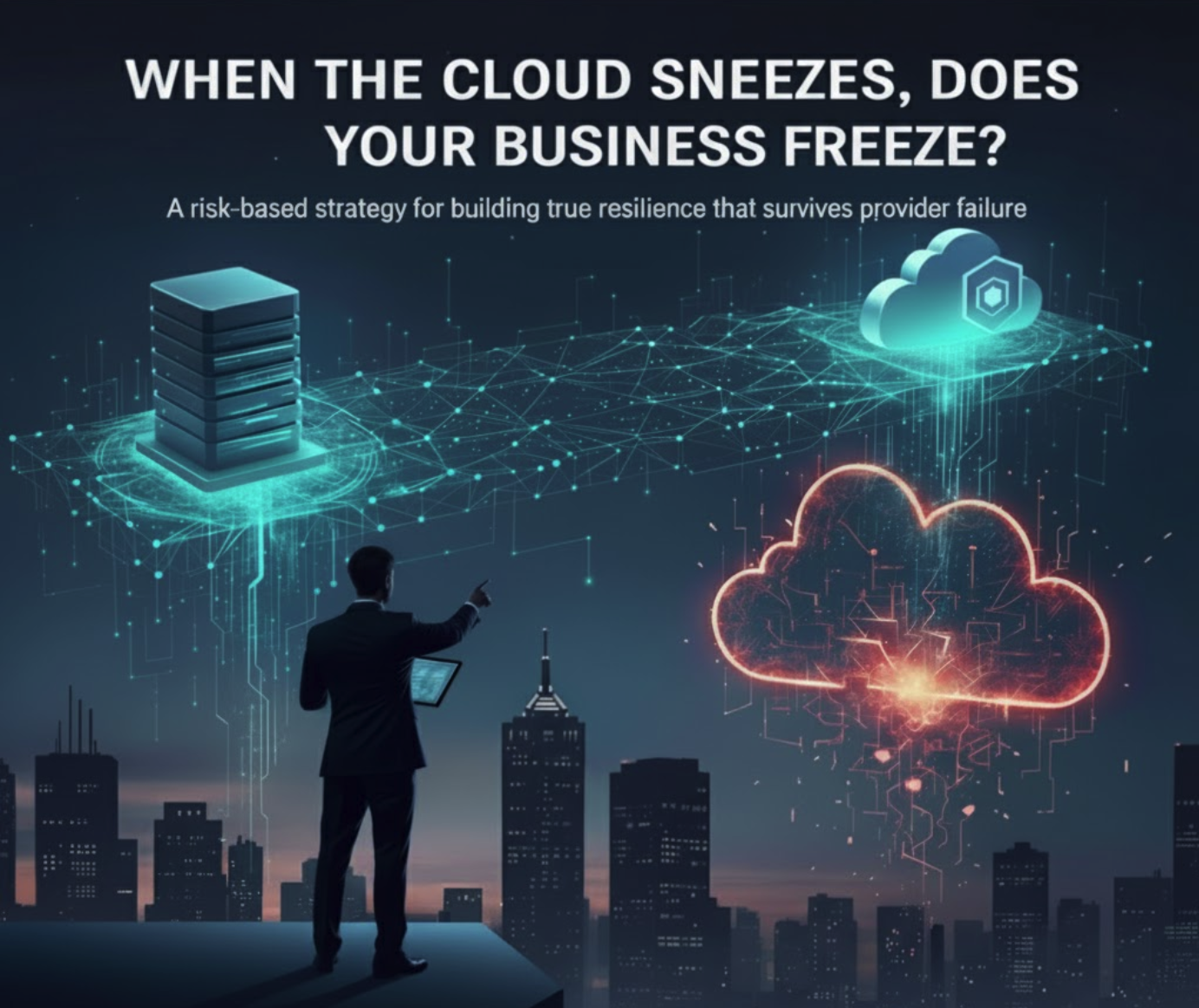
When the Cloud Sneezes, Does Your Business Freeze? What the AWS Outage Teaches Us About Risk-Based Cloud Strategy
On 20 October 2025, parts of the internet went dark.
An outage in Amazon Web Services (AWS) — specifically in the US-EAST-1 region, one of its largest and most interconnected data center regions — caused widespread errors and latency across multiple services, including Amazon DynamoDB.
Within minutes, global platforms like Slack, Zoom, Canva, Xero, and even government portals such as HMRC (UK) began showing signs of disruption.
Millions of businesses across Europe and the Netherlands noticed it immediately: chats stalled, meetings froze, and dashboards went blank.
This was not a cyberattack or a global power failure — it was a single-provider dependency unfolding in real time.
The Hidden Single Point of Failure
Public clouds are often seen as the ultimate solution for resilience. But resilience isn’t automatically inherited from the provider — it must be designed by the customer.
When a region like US-EAST-1 experiences issues, the impact isn’t limited to that geography. Many global applications route authentication, data, or logging through that region by default.
In this case, the failure of DynamoDB, AWS’s NoSQL database, triggered cascading errors across multiple dependent services.
From a business perspective, the outage illustrates a recurring theme:
Cloud dependency can easily become cloud fragility when risk is not actively managed.
Even organizations that think they are multi-region or multi-zone may still rely on control planes or managed services concentrated in one location.
Five Architectural Paths, and Their Trade-offs
No architecture is risk-free. But every architecture makes a choice about where risk lives.
| Strategy | Description | Strengths | Limitations |
| Single Public Cloud | All workloads run within one provider (e.g. AWS, Azure, GCP). | Simplicity, consistency, lower cost. | High dependency , if the provider fails, you fail. |
| Multi-Cloud | Workloads distributed across 2+ cloud providers. | Resilience, vendor independence. | Complex operations, diverse tooling, skill overhead. |
| Multi-Region (same provider) | Active-active or failover deployments across cloud regions. | Low latency, improved availability. | Still tied to one provider’s network and control plane. |
| Hybrid (Public + Private) | Combines on-prem or private cloud with public cloud elasticity. | Best balance of control, compliance, and flexibility. | Requires solid integration and security governance. |
| Private Cloud | Fully self-hosted or privately managed infrastructure. | Full sovereignty, custom security posture. | Highest operational burden, limited scalability. |
Each model comes with trade-offs, not just in cost, but in governance, compliance, and recovery maturity.
That’s why a risk-based cloud strategy is essential.
Designing for Risk: From Dependency to Resilience
Moving to (or scaling within) the cloud should start with a risk assessment, not a migration plan.
A few guiding questions can make all the difference:
- Impact: What happens to our business if this workload becomes unavailable for 2 hours?
- Dependency: Which managed services (e.g., DynamoDB, S3, Lambda) are single points of failure?
- Sovereignty: Where is data physically stored and what are our legal obligations under GDPR or NIS2?
- Recovery: What are our RTO (Recovery Time Objective) and RPO (Recovery Point Objective) targets?
- Detection: Are our observability tools distributed, or do they fail with the same provider?
True resilience means expecting failure and designing pathways around it.
It’s not just about backup. It’s about continuity of service under degraded conditions.
From Awareness to Action: Build, Design, and Plan for Resilience
The AWS outage reminded everyone that reliability is never absolute — it’s engineered.
Building true resilience means moving beyond reactionary incident response and embedding risk thinking into every stage of design.
Here are the three core principles that every organization should apply to cloud architecture, regardless of scale or provider:
1. Build for Failure
Assume that components, zones, and even providers will fail.
Design systems so that a single point of failure. Whether it’s a DNS resolver, a managed service, or a region that fails, it should not take down your business.
- Distribute workloads across availability zones and regions.
- Use redundant DNS, storage, and message queues.
- Implement graceful degradation, your system should bend, not break.
- Test failure scenarios regularly (chaos engineering, simulated outages).
Building for failure isn’t pessimism, it’s maturity.
2. Design for Recovery
Outages happen. The differentiator is how fast and how completely you can recover.
Recovery design means understanding both technical restoration and service continuity:
- Automate redeployment and data restoration via Infrastructure-as-Code.
- Predefine Recovery Time Objectives (RTO), Recovery Point Objectives (RPO) for each workload and for the stack as a whole
- Validate identity, observability, and automation pipelines — they are often dependencies for recovery.
- Ensure customers experience gradual degradation rather than sudden loss of service.
The goal is not just uptime, it’s recoverable capability.
3. Plan for Disruption
Not every disruption is technical.
A comprehensive Business Continuity Plan (BCP) connects the dots between technical recovery and organizational response.
- Define clear communication playbooks for customers and partners.
- Map critical business processes to their supporting IT services.
- Include cloud service dependencies in continuity testing.
- Align with ISO 22301 and NIS2 continuity requirements for operational resilience.
Disruption planning ensures that your organization continues to operate, even when your cloud doesn’t.
Build for failure. Design for recovery. Plan for disruption.
Together, these principles turn cloud dependency into cloud resilience and transform outages from existential risks into operational exercises.
Moving Forward: Cloud Maturity Through Risk Awareness
Cloud computing remains transformative.
But the responsibility for resilience sits with the architecture, not within the provider SLA.
Organizations adopting or expanding their infrastructure, private cloud and/or public cloud usage should:
- Establish cloud governance frameworks based on risk categories.
- Implement multi-region or hybrid patterns for critical workloads.
- Use observability platforms that monitor dependencies across providers.
- Regularly test failover and incident response playbooks.
- Align architectures with ISO 27001, SOC2, and NIS2 resilience requirements.
Conclusion
The AWS outage wasn’t an anomaly — it was a reminder.
Cloud enables agility, scalability, and innovation, but true reliability must be engineered.
As architects and business leaders, we should ask ourselves with every new deployment:
“If this fails — how do we continue to serve our customers?”
The answer defines not only your architecture, but your business resilience.
🔒 Ready to strengthen your cloud resilience?
TechGourmet helps organizations design hybrid and multi-cloud architectures
built for failure, recovery, and continuity.
Let’s assess your current cloud risks and translate them into actionable
architecture improvements.

